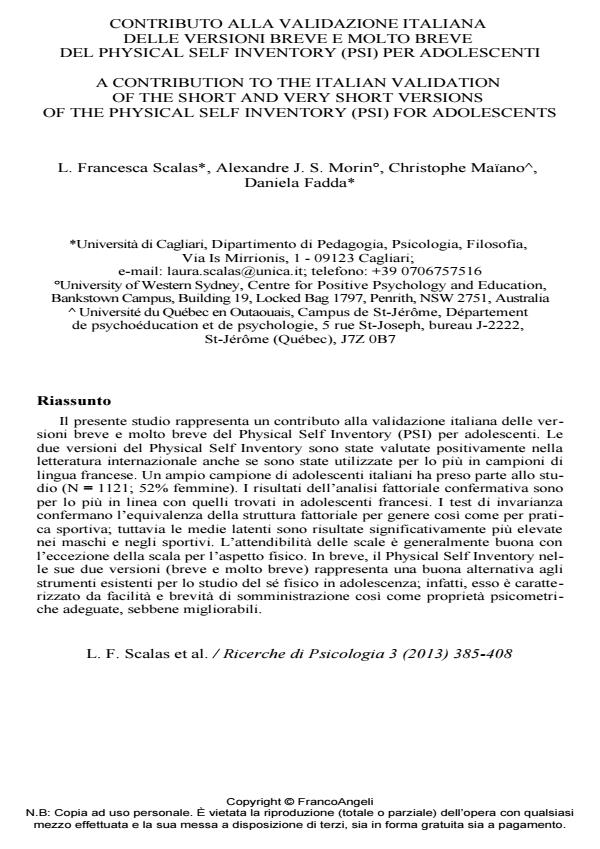Contributo alla validazione italiana delle versioni breve e molto breve del physical self inventory (psi) per adolescenti
Titolo Rivista RICERCHE DI PSICOLOGIA
Autori/Curatori L. Francesca Scalas, Alexandre J.S. Morin, Christophe Maiano, Daniela Fadda
Anno di pubblicazione 2014 Fascicolo 2013/3
Lingua Italiano Numero pagine 24 P. 385-408 Dimensione file 299 KB
DOI 10.3280/RIP2013-003001
Il DOI è il codice a barre della proprietà intellettuale: per saperne di più
clicca qui
Qui sotto puoi vedere in anteprima la prima pagina di questo articolo.
Se questo articolo ti interessa, lo puoi acquistare (e scaricare in formato pdf) seguendo le facili indicazioni per acquistare il download credit. Acquista Download Credits per scaricare questo Articolo in formato PDF

FrancoAngeli è membro della Publishers International Linking Association, Inc (PILA)associazione indipendente e non profit per facilitare (attraverso i servizi tecnologici implementati da CrossRef.org) l’accesso degli studiosi ai contenuti digitali nelle pubblicazioni professionali e scientifiche
Il presente studio rappresenta un contributo alla validazione italiana delle versioni breve e molto breve del Physical Self Inventory (PSI) per adolescenti. Le due versioni del Physical Self Inventory sono state valutate positivamente nella letteratura internazionale anche se sono state utilizzate per lo piu in campioni di lingua francese. Un ampio campione di adolescenti italiani ha preso parte allo studio (N = 1121; 52% femmine). I risultati dell’analisi fattoriale confermativa sono per lo piu in linea con quelli trovati in adolescenti francesi. I test di invarianza confermano l’equivalenza della struttura fattoriale per genere cosi come per pratica sportiva; tuttavia le medie latenti sono risultate significativamente piu elevate nei maschi e negli sportivi. L’attendibilita delle scale e generalmente buona con l’eccezione della scala per l’aspetto fisico. In breve, il Physical Self Inventory nelle sue due versioni (breve e molto breve) rappresenta una buona alternativa agli strumenti esistenti per lo studio del se fisico in adolescenza; infatti, esso e caratterizzato da facilita e brevita di somministrazione cosi come proprieta psicometriche adeguate, sebbene migliorabili.
Parole chiave:Physical Self-Inventory, validazione italiana, analisi fattoriale confermativa, invarianza per genere, invarianza per pratica sportiva, adolescenza.
- Validity and reliability of the Very Short form of the Physical Self-Inventory among Turkish adolescents F. Hülya Aşçi, Christophe Maïano, Alexandre J. S. Morin, Emine Çağlar, Naile Bilgili, in Journal of Sports Sciences /2017 pp.2060
DOI: 10.1080/02640414.2016.1255346
L. Francesca Scalas, Alexandre J.S. Morin, Christophe Maiano, Daniela Fadda, Contributo alla validazione italiana delle versioni breve e molto breve del physical self inventory (psi) per adolescenti in "RICERCHE DI PSICOLOGIA " 3/2013, pp 385-408, DOI: 10.3280/RIP2013-003001